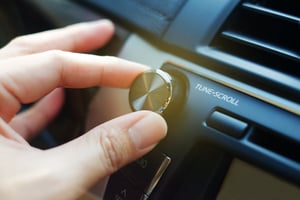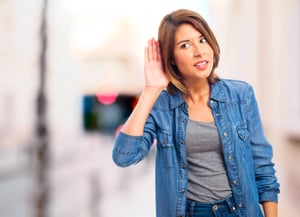Four Tips for Active and Intentional Listening
Candidly, I find, that collectively, we just don’t listen the way we used to. My kids are teenagers now, so their listening is filtered through a lens of ‘Do I want to listen to my parents or not?’ In my forties, my ability to hear things and decipher through the noise of the background is admittedly less effective than it used to be. And watching my parents and their friends interact, it’s apparent their hearing is less acute than it once was, making listening and conversing more difficult. Just the other day we sat around the table joking ‘well if everyone would stop mumbling then we could all hear each other better’
If everyone really is mumbling, listening might be something we should talk about a little bit more. So, we’re offering four tips for how we can actively and intentionally listen better together.
Years ago, I read that when we have to repeat something a third time it creates annoyance, both in me, the communicator, as well as in you, the recipient. If I say something once, that’s fine, a second time it’s okay, but by the third time I’m nagging. Some relationships can handle the nagging, but many can’t. So, these four little tips will help us hear each other better the first time and create good habits for better listening.
1. Actively and Intentionally Eliminate the Noise.
 How often do we turn up the volume on the TV to hear it over the other household noises around us? Or, how often do we turn up the volume on the car radio to hear it over the street noise outside? But how often do we turn down the noise around us to hear the person right in front of us?
How often do we turn up the volume on the TV to hear it over the other household noises around us? Or, how often do we turn up the volume on the car radio to hear it over the street noise outside? But how often do we turn down the noise around us to hear the person right in front of us?
When we engage in conversation, the first thing we should do is eliminate the noise around us. This might be the literal, physical noise around us, like electronics, a passing car, or a secondary conversation going on nearby. Or this might be the more figurative noise going on in our heads or our environments like distracting cell phones, a bad mood, or irritated feeling. Turning all these things down, or ideally, eliminating them altogether, will help us listen better.
We’ve found one of the best ways to eliminate the noise is to say, out loud, ‘I’m going to turn down the noise so we can listen to each other.” For example, when my kids were little, we used to have an arrangement. I would say their names, “Anja, Sophie,” as a cue to them that I had something to say. They would pause their electronics or put down their toys, make eye contact with me, and say, “Yes Mom,” as a cue to me that they were ready to listen. Only then did we all know the noise had been eliminated and we were ready to communicate.
2. Maintain Two Points of Contact.
I was recently on a sailboat where I was advised, in rough waters, keep three points of contact on the boat at all times. This meant I should always have two feet and a hand, or a knee, a foot, and a hand, or two hands and a foot, on the boat at all times. Three points of contact allowed me more stability as I moved around the boat in the choppy waters, and less of a chance of losing my balance or falling over.
To extend this analogy to our communication, I would encourage all of us to keep two points of contact in every communication for even better listening. This might mean we keep eye contact while speaking to each other. Or, perhaps, we look at the same document while discussing its contents over the phone. Or, if we know the person we’re communicating with prefers physical touch as a language of appreciation, we could place our hand on their shoulder during a conversation as a second point of contact.

Of course, all these options require some discretion and intuition but, if we have two points of contact in our communication, we can set ourselves up for even better listening. This technique can be especially helpful in today’s heavily distracted world of electronics. If the person we are talking to is looking down at their phone while also “engaging” in conversation, there is a decent chance the words are not registering. They might be hearing, but they are not listening. Two points of contact ensures both hearing and listening.
3. Listen for understanding.
If we listen, not with the intent to correct, criticize, or respond, but with the intent to understand what the other person is saying, I believe a whole heck of a lot of miscommunications can be avoided altogether.
When our thoughts are shaded by the other thoughts in our head or our feelings for the speaker, it can be so difficult to understand what we are hearing. When we are in communication with others, we are in constant battle with our own bad moods and snippy tempers or our own desires to correct what we are hearing and prove that we know more than the other person does in this situation. But if we listen to understand what the other person is saying, we have a much better shot at actually hearing them and moving forward with a productive conversation.
4. Say what you heard.
Sometimes, even if we eliminate the noise, maintain a second point of contact, and listen for understanding, we still don’t hear the message right.
The other day, while I was pulling weeds in the gardens, my daughter walked up to me and said, “I wanted to ask you something.” Feeling a bit thrown off by what I thought I just heard, I repeated it back to her, “You want Tobasco on something?”
 Obviously, in this moment she was not talking about hot sauce. But, if I’d thought she was, our conversation could have gotten way off track. This technique can help us avoid starting off a conversation on the wrong foot. If I repeat the improbable thing I think I just heard, instead of moving forward with a mis-perception or an irritation, we can move forward with a productive conversation.
Obviously, in this moment she was not talking about hot sauce. But, if I’d thought she was, our conversation could have gotten way off track. This technique can help us avoid starting off a conversation on the wrong foot. If I repeat the improbable thing I think I just heard, instead of moving forward with a mis-perception or an irritation, we can move forward with a productive conversation.
Another way this tip can be useful is by helping us avoid confusion when we say something we didn’t mean to say.
For example, I might have known very well we’re going to meet up with Chuck and Sue on Tuesday, and yet, for some reason I said, “we are going to meet up with Chuck and Sue on Monday.” By repeating what you’ve heard back to me, “We’re meeting up with Chuck and Sue on Monday?”, I have a chance to catch and correct myself.
Say back what you heard, not in a corrective or irritated way, but perhaps in a gentle question or a ‘did I hear you right?’ or ‘here’s what I heard…’. This will help us all listen better and lead to even better communication.
So, here we have four simple tips to help us listen better together. Eliminate the noise, make two points of contact, listen for understanding, and say what you heard. Which one will you try? Let us know how it works for you!








